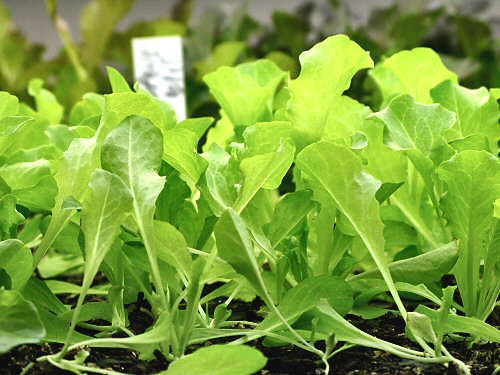
More early lettuce. This is Simpson Elite, an improved variety of Black Seeded Simpson, which is a really fast, reliable heirloom from the 1800’s. I grow both. They have thin, delicate, pale green leaves, but they’ve proven tough in heat, drought and cold. And they’re 40-45 days! These seedlings are now about 3-1/2 weeks old. I still haven’t thinned them from two per cell—all the lettuce looks so…pretty, densely bunch in their trays, and they’re stretching a bit, but just this side of really crowding each other. Anyhow, it’s the super-early lettuce…mostly for fun! (This is also my first tryout of the latest new farm tool, a Canon G9…a sturdy, field-ready bit of gear… :)




Agreed on the Black Simpson–has survived everything the winter has thrown at it down here and still chugging along. The Endive/escarole types have also done great.
I have some growing in my lawn (North Texas area), not well, but it is alive.
I just bought some from a local organic store… I planted them in pots until my garden is ready. I’m in MD so we’re not cleared of frosty nights just yet. When/how do I harvest lettuce? This is my first try at gardening vegetables other than tomatoes in pots on a balcony!!! :-) Thanks for any advice or tips you can give this gardening newby!
Andrea: Lettuce is real easy, as long as you don’t have deer or rabbits or anything else that munches on it. Simpson Elite is a leaf lettuce, the individual leaves stand out (not like head lettuce, your typical iceberg lettuce, which is balled up kinda like cabbage), so you can pick off the big outer leaves for a while, it’ll keep growing, you keep picking! This way, you can get fresh salad for maybe 3-4 weeks. After that, it’ll start going to seed, it’ll start growing tall and pointy, and at that point, the leaves turn bitter (you’ll know it when you see it happening…!) Or you can wait till it looks nice and full and cut the whole thing off at the stem. That’d be around the days to maturity date that’s probably on the seed package. Simpson Elite is around 45 to 50 days from germination.
With lettuce, you should plant several times in the season. This is called succession planting. Instead of planting, say, 12 plants at one time, plant 4, wait 2-3 weeks, plant 4 more, and wait and plant again. That way, you don’t get a whole lot of lettuce all at once, and then none. Some veggies produce all season, like tomatoes, but others you’ll probably want to succession plant to keep a steady supply.
Veggie gardening is real easy. It can seem complicated before you try, but as soon as you’ve grown and EATEN just one successful crop, you’ll be hooked and you’ll be waaaaay more confident. And don’t worry if something doesn’t work out, just keep planting. a little experience is everything!
A good garden book that you like browsing is also indispensable. But an easy start is to look up your crops on the web, like “how to grow lettuce.” Read a few of the pages you find. Don’t worry about all the different details, just pick up what seems useful to you… Once you’ve grown something, it’ll all make much easier sense.
If you like radishes, try those, just seed ’em directly in the garden right now, don’t worry about cold snaps. Radishes grow fast, around 30 days, and they like cool weather, they generally don’t do well in the really hot summer. They’re good for a quick first harvest at this time of year.
It’ll be great!
Your Simpson Elite looks like it’s laying over in the trays. Did they do that early on, like just after they got their first true leaves? I have some SE lettuce seedlings that look like they have damping-off, but they seem to be growing still. Curious…
Sean: Yes, they are indeed laying over. They’re pretty crowded in 72-cell trays, under weak fluorescent light, and Simpson Elite grows particularly fast, so you have to raise the lights to cover the whole tray, which in turn makes them stretch. You do what you can!
I only have so much room under lights, and I have lots to start, so there’s always a trade-off.
I’ve experimented with transplanting really tiny seedlings, so they don’t have time to stretch, and that has worked, but it’s also tricky, because they’re so small and undeveloped, they’re much more likely to die in the field if the ground dries out, or wind dries them out, before they get established. In hotter, drier weather, you spend time watering.
On the other hand, if seedlings get a little crowded and stretched in trays, they’re still much more forgiving to plant out. They may take an extra week or two to re-establish in the great outdoors, and this also depends on the particular crop, but that seems to work out for me.
I could add lots more lights, or bump up from fluorescent to high intensity lighting. Ideally, I could heat the greenhouse and keep seedlings out there when the weather is still cold. That’d be great, with natural light, and no hardening off required. BUT, heating is quite expensive, and you also have to monitor temperature and ventilation, because it can get too hot in there on sunny days. So, more money and work.
In veggie gardening, there are always improvements and trade-offs and different ways of doing things. I’m always finding new methods to try and experimenting on my own. That’s a big part of the fun! :)